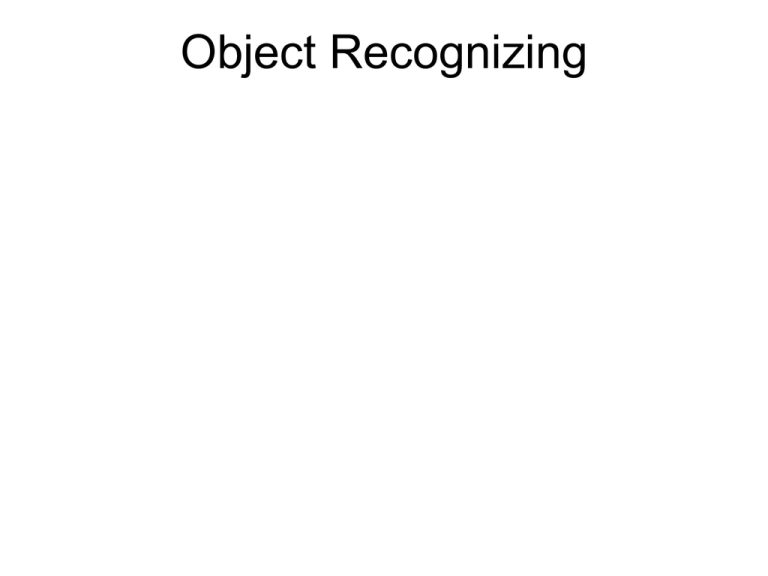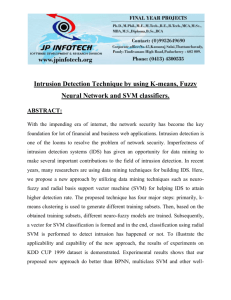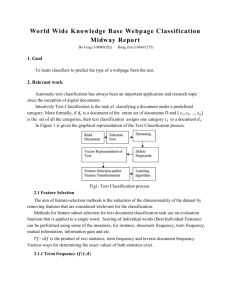Slides
advertisement

Object Recognizing Recognition -- topics • Features • Classifiers • Example ‘winning’ system Object Classes Individual Recognition Object parts Automatic, or query-driven Window Mirror Window Door knob Headlight Back wheel Bumper Headlight Front wheel Class Non-class Variability of Airplanes Detected Class Non-class Features and Classifiers Same features with different classifiers Same classifier with different features Generic Features: The same for all classes Simple (wavelets) Complex (Geons) Class-specific Features: Common Building Blocks Optimal Class Components? • Large features are too rare • Small features are found everywhere Find features that carry the highest amount of information Entropy Entropy: H - p(xi ) log2 p(xi ) x = 0 1 H p = 0.5 0.1 0.01 0.5 0.9 0.99 ? 0.47 0.08 Mutual information H (c) P(c)Log(P(c)) H(C) F=1 H(C) when F=1 F=0 H(C) when F=0 I(C;F) = H(C) – H(C/F) Mutual Information I(C,F) 0 0 1 0 1 0 1 1 Class: 0 0 1 1 1 0 0 1 Feature: I(F,C) = H(C) – H(C|F) Optimal classification features • Theoretically: maximizing delivered information minimizes classification error • In practice: informative object components can be identified in training images Selecting Fragments forehead Mutual Info vs. Threshold hairline Mutual Info mouth eye nose nosebridge 0.00 20.00 Detection threshold 40.00 long_hairline chin twoeyes Horse-class features Car-class features Pictorial features Learned from examples Star model Detected fragments ‘vote’ for the center location Find location with maximal vote In variations, a popular state-of-the art scheme Bag of words 1.Feature detection and representation Bag of visual words Regular • A large collection ofgrid image patches Vogel & Schiele, 2003 – Fei-Fei & Perona, 2005 – – Generate a dictionary using K-means clustering Recognition by Bag of Words (BoD): Each class has its words historgram – – – Limited or no Geometry Simple and popular, no longer state-of-the art. HoG Descriptor Dallal, N & Triggs, B. Histograms of Oriented Gradients for Human Detection Shape context Recognition Class II: SVM Example Classifiers SVM – linear separation in feature space -1 0 Separating line: Far line: Their distance: Separation: Margin: +1 The Margin w∙x+b=0 w ∙ x + b = +1 w ∙ ∆x = +1 |∆x| = 1/|w| 2/|w| Max Margin Classification The examples are vectors xi The labels yi are +1 for class, -1 for non-class (Equivalently, usually used How to solve such constraint optimization? Solving the SVM problem • • • • Duality Final form Efficient solution Extensions Using Lagrange multipliers: Using Lagrange multipliers: Minimize LP = With αi > 0 the Lagrange multipliers Minimizing the Lagrangian Minimize Lp : Set all derivatives to 0: Also for the derivative w.r.t. αi Dual formulation: Maximize the Lagrangian w.r.t. the αi and the above two conditions. Solved in ‘dual’ formulation Maximize w.r.t αi : With the conditions: Dual formulation Mathematically equivalent formulation: Can maximize the Lagrangian with respect to the αi After manipulations – concise matrix form: Summary points • • • • Linear separation with the largest margin, f(x) = w∙x + b Dual formulation Natural extension to non-separable classes Extension through kernels, f(x) = ∑αi yi K(xi x) + b Felzenszwalb • Felzenszwalb, McAllester, Ramanan CVPR 2008. A Discriminatively Trained, Multiscale, Deformable Part Model • Many implementation details, will describe the main points. Using patches with HoG descriptors and classification by SVM Person model HoG orientations with w > 0 Object model using HoG A bicycle and its ‘root filter’ The root filter is a patch of HoG descriptor Image is partitioned into 8x8 pixel cells In each block we compute a histogram of gradient orientations Dealing with scale: multi-scale analysis The filter is searched on a pyramid of HoG descriptors, to deal with unknown scale Adding Parts A part Pi = (Fi, vi, si, ai, bi). Fi is filter for the i-th part, vi is the center for a box of possible positions for part i relative to the root position, si the size of this box ai and bi are two-dimensional vectors specifying coefficients of a quadratic function measuring a score for each possible placement of the i-th part. That is, ai and bi are two numbers each, and the penalty for deviation ∆x, ∆y from the expected location is a1 ∆ x + a2 ∆y + b1 ∆x2 + b2 ∆y2 Bicycle model: root, parts, spatial map Person model Match Score The full score of a potential match is: ∑ Fi ∙ Hi + ∑ ai1 xi + ai2 yi + bi1xi2 + bi2yi2 Fi ∙ Hi is the appearance part xi, yi, is the deviation of part pi from its expected location in the model. This is the spatial part. Using SVM: The score of a match can be expressed as the dot-product of a vector β of coefficients, with the image: Score = β∙ψ Using the vectors ψ to train an SVM classifier: β∙ψ > 1 for class examples β∙ψ < 1 for class examples β∙ψ > 1 for class examples β∙ψ < 1 for class examples However, ψ depends on the placement z, that is, the values of ∆xi, ∆yi We need to take the best ψ over all placements. In their notation: Classification then uses β∙f > 1 We need to take the best ψ over all placements. In their notation: Classification then uses β∙f > 1 Recognition search with gradient descent over the placement. This includes also the levels in the hierarchy. Start with the root filter, find places of high score for it. For these high-scoring locations, each for the optimal placement of the parts at a level with twice the resolution as the root-filter, using GD. Essentially maximize ∑ Fi Hi + ∑ ai1 xi + ai2 y + bi1x2 + bi2y2 Over placements (xi yi) Final decision β∙ψ > θ implies class • Training -- positive examples with bounding boxes around the objects, and negative examples. • Learn root filter using SVM • Define fixed number of parts, at locations of high energy in the root filter HoG • Use these to start the iterative learning Hard Negatives The set M of hard-negatives for a known β and data set D These are support vector (y ∙ f =1) or misses (y ∙ f < 1) Optimal SVM training does not need all the examples, hard examples are sufficient. For a given β, use the positive examples + C hard examples Use this data to compute β by standard SVM Iterate (with a new set of C hard examples) All images contain at least 1 bike Future challenges: • Dealing with very large number of classes – Imagenet, 15,000 categories, 12 million images • To consider: human-level performance for at least one class











